
Sideloading add-ins requires at minimum the My Custom Apps role for your Exchange Server.

You can install an add-in if your mailbox is on Exchange. Install the add-inĪfter preparing the add-in manifest file and deploying the add-in UI to a web server that can be accessed, you can sideload the add-in for a mailbox on an Exchange server by using an Outlook client, or install the add-in by running remote Windows PowerShell cmdlets. After initially deploying the source files for the add-in, you can update the add-in UI and behavior by replacing the HTML files or JavaScript files stored on the web server with a new version of the HTML file. The resulting source files are stored on a web server that can be accessed by the Exchange server that hosts the add-in.

You can use HTML and JavaScript to create the add-in. For information about how to create a manifest file, see Outlook add-in manifests. We'll assume that you store your manifest in a local folder. You can store the manifest in a local folder or server, as long as the location is accessible by the Exchange server of the mailbox that you're testing with.

Create a manifest file for the add-inĮach add-in is described by a manifest, a document that gives the server information about the add-in, provides descriptive information about the add-in for the user, and identifies the location of the add-in UI HTML file. Custom panes have been deprecated so please ensure that you're using a supported add-in extension point.


 0 kommentar(er)
0 kommentar(er)
